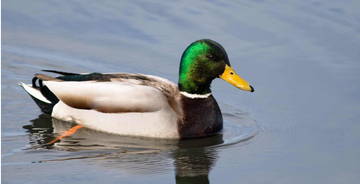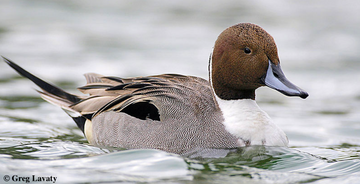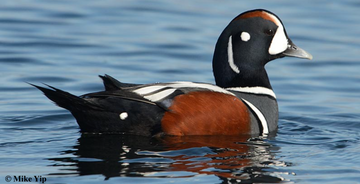Waterfowl Identification
Ducks are a type of waterfowl, and there are many different species. Some of the most popular are mallards, pintails, and teals; but there are also diving ducks and sea ducks that you might not be as familiar with. In this guide we'll take an in-depth look at each type of duck so that you can learn more about their behavior and habitat preferences so you can better identify them when you see them outside!
Dabbling Ducks
Dabbling ducks are a group of waterfowl species known for their unique feeding behavior. These ducks are characterized by their relatively small size, compact bodies, and webbed feet that allow them to swim with ease. They typically feed by tipping their heads down into the water, using their bills to sift through the mud and vegetation at the bottom of ponds, lakes, and rivers. With their bright colors and distinctive markings, dabbling ducks are a beautiful sight to behold. From the iridescent green head of the mallard to the dappled brown and white feathers of the northern pintail, each species has its own unique charm. Whether swimming peacefully on the water's surface or taking to the skies in a graceful flight, dabbling ducks are truly a delight to observe.

Mallard
The mallard is a common and well-known puddle duck, known for its striking appearance and versatile behavior. With its vibrant green head, brownish-gray wings, and white neck-ring, the male mallard is easily recognizable. The female mallard, on the other hand, has a more muted brown plumage, with a distinctive orange bill. They feed in shallow water or on land, dabbling for aquatic vegetation, insects, and small fish. Mallards are highly adaptable and can be found in a variety of habitats, from urban parks to rural wetlands. In the spring, they build their nests on the ground, often hidden among tall grasses or other vegetation. Mallards are also known for their impressive flight, with a wingspan of up to 36 inches.

Wood Duck
The wood duck is one of the most beautiful and colorful waterfowl species in North America. The male wood duck has a distinctive and striking plumage, with iridescent green and purple feathers on its head and neck, a white stripe that extends from the eye to the back of the head, a red eye, and a chestnut-colored breast. The female wood duck, on the other hand, is less colorful but still stunning, with a gray-brown head and a white teardrop-shaped patch around the eye. These ducks nest and roost in trees. They are found in a variety of habitats, from swamps and marshes to wooded ponds and streams. Wood ducks are excellent swimmers and divers, and they feed on a variety of aquatic plants, insects, and fish.

American Wigeon
The American wigeon, also known as the baldpate, is a medium-sized dabbling duck found throughout North America. These ducks are easily recognizable by their broad, round heads, and the male's distinctive white forehead and green band behind the eye. The male also has a beautiful chestnut-colored head and neck, with a gray-blue bill and a white patch on the crown. The female, on the other hand, has a mottled brown plumage with a grayish-blue bill. American wigeons are social birds and are often found in large flocks. They prefer to feed in shallow water, where they can easily reach aquatic vegetation and small invertebrates. These ducks are also excellent fliers, with a fast and agile flight that is a joy to watch.

Northern Pintail
The northern pintail is a graceful and elegant duck species found throughout the Northern Hemisphere. These birds are easily recognizable by their long, slender necks, pointed tails, and striking plumage. The male has a chocolate-brown head and neck, a white breast, and a long, slender gray bill. The female is less colorful, with a mottled brown plumage and a shorter bill. Northern pintails are migratory birds that breed in the northern parts of their range and winter in the southern regions. They prefer to feed in shallow water, where they can easily reach aquatic plants and invertebrates. These ducks are also excellent fliers, with a swift and graceful flight that is a pleasure to watch.

Green-Winged Teal
The green-winged teal is a small and colorful duck species found throughout North America. These ducks are easily recognizable by their striking plumage, with the male having a chestnut-colored head, a green patch on the side of the face, and a metallic green patch on the wing. The female has a mottled brown plumage with a green patch on the wing. Green-winged teals are dabbling ducks that prefer shallow water habitats, where they can easily feed on aquatic plants and invertebrates. They are also excellent fliers, with a fast and agile flight that is a joy to watch. These ducks are highly migratory, breeding in the northern parts of their range and wintering in the southern regions.

Gadwall
The gadwall is a medium-sized duck species found throughout the world, with a distinctive plumage that sets it apart from other dabbling ducks. The male has a grayish-brown head and neck, a black rump, and a distinctive white patch on the wings that is visible in flight. The female is less colorful, with a mottled brown plumage and a similar white patch on the wings. Gadwalls are dabbling ducks that prefer shallow water habitats, where they can easily feed on aquatic plants, insects and invertebrates. They are also excellent fliers, with a swift and agile flight that is impressive to watch. These ducks breed in the northern regions of their range and migrate to southern areas for the winter.

Northern Shoveler
The northern shoveler is a duck species found throughout North America, Europe, and Asia, with a distinctive appearance that makes it easy to identify. The male has a large bill that is broad and flat, perfect for the way it feeds by sweeping back and forth through the water, straining out small aquatic organisms. The male also has a striking plumage, with a glossy green head, a white breast, and chestnut-colored flanks. The female is less colorful, with a mottled brown plumage and a similar bill that makes it easy to distinguish from other duck species. Northern shovelers prefer shallow water habitats, where they can easily feed on aquatic plants and invertebrates.
Read MoreDiving Ducks
Diving ducks are a group of waterfowl species that are known for their remarkable underwater diving abilities. Unlike dabbling ducks that feed on the surface of the water, diving ducks are adapted for diving to the bottom of the water to feed on aquatic invertebrates, fish, and plants. These ducks have a streamlined body, with a thick neck and a powerful bill that helps them forage underwater. They also have a specialized respiratory system that allows them to remain underwater for extended periods of time, diving to depths of up to 60 feet. Diving ducks are also excellent swimmers, with webbed feet that are designed for propulsion and maneuvering underwater. These ducks are found in a wide range of habitats, from deep lakes to coastal waters, and are highly migratory, traveling long distances between their breeding and wintering grounds. Diving ducks come in a variety of species, including the common merganser, tufted duck, and canvasback, each with their unique physical characteristics and behaviors. These incredible birds are a true wonder of nature, with their specialized adaptations and remarkable abilities underwater.

Canvasback
Canvasback ducks are a species of diving duck that are known for their striking appearance and exceptional diving abilities. These ducks have a distinctive sloping profile, with a large head and a long, narrow bill that is perfect for feeding on aquatic plants and invertebrates. The male has a chestnut-red head and neck, a black breast, and a white body, while the female is more muted, with a brownish-gray plumage. Canvasback ducks are also excellent swimmers, with webbed feet that are designed for propulsion and maneuvering underwater. They are capable of diving to depths of up to 30 feet to forage for food, staying underwater for up to 30 seconds at a time. These ducks are found in a variety of habitats, including large lakes, rivers, and coastal areas, and are highly migratory, breeding in the northern parts of their range and wintering in the southern regions.

Redhead
Redhead ducks are a beautiful species of waterfowl known for their striking redheads and grayish bodies. The males have a bright red head, neck, and upper breast, with a black lower breast and gray body, while the females are more muted, with a brownish-gray plumage. These ducks are medium-sized, with streamlined bodies, a long neck, and a rounded head. They are diving ducks, adapted for feeding on aquatic vegetation, invertebrates, and small fish. Redhead ducks are excellent swimmers, with webbed feet that are designed for propulsion and maneuvering underwater. They are also capable of flying at high speeds, with a wingspan of up to 36 inches. Redhead ducks live in a variety of habitats, including shallow lakes and marshes near the coast. They breed in northern regions and then migrate south for warmer weather during winter months.

Bufflehead
The Bufflehead Duck is a small diving duck that is native to North America. With its striking black and white plumage and iridescent green and purple head, the Bufflehead is a favorite among birdwatchers and hunters alike. This species is known for its agility and speed, making it an elusive target for hunters. As a highly migratory bird, the Bufflehead is found in a variety of habitats, including freshwater lakes, rivers, and coastal bays. These ducks are adapted for diving, with webbed feet and a streamlined body that allows them to swim and forage for food underwater. Buffleheads feed on a diet of aquatic invertebrates, crustaceans, and small fish. For those interested in birdwatching or hunting, the Bufflehead is a fascinating species to observe and study. With its unique markings and impressive diving skills, this small duck is a true delight to encounter in the wild.

Ring-Necked Duck
The Ring-Necked Duck is a unique waterfowl species that is found throughout North America. With its distinctive black and gray plumage and white ring around its bill, this species is a favorite among birdwatchers and hunters alike. The Ring-Necked Duck is a diving duck, adapted for feeding on aquatic vegetation, invertebrates, and small fish by diving to the bottom of the water. The Ring-Necked Duck is a highly agile water bird with webbed feet that help it swim and maneuver underwater. As a migratory species, this duck can be found living in freshwater lakes, rivers—even coastal bays.

Hooded Merganser
The Hooded Merganser is a stunning waterfowl species found in North America. With its striking black and white plumage, distinctive crest on its head, and bright yellow eyes, this species is a favorite among birdwatchers and wildlife enthusiasts. The Hooded Merganser is a diving duck that has adapted its webbed feet to help it swim and maneuver underwater and catch small fish, crustaceans, and aquatic insects. The Hooded Merganser is found in a variety of habitats, including freshwater lakes and rivers. With its unique markings and appearance, this species is a true gem of the avian world.

Scaup Duck
The Scaup duck is a magnificent diving duck found in North America. The Greater Scaup and Lesser Scaup are two duck species often found together, but their size and appearance can be distinguished. This species is a favorite among birdwatchers and hunters with its striking black and white plumage. The Scaup duck is an aquatic duck with webbed feet that allow it to swim and dive. This animal feeds on mollusks, crustaceans, plants—and sometimes small fish. Known as a "migratory bird," the Greater Scaup can be found in freshwater lakes, rivers, and coastal bays.
Sea Ducks
Sea Ducks are a fascinating group of birds that are adapted to life on the water. These birds are found in a variety of habitats, from coastal bays and estuaries to offshore waters. Sea Ducks are known for their amazing diving abilities, which allow them to feed on a variety of prey, including fish, crustaceans, and mollusks. These birds have a number of adaptations that make them perfectly suited to life on the water, including webbed feet for swimming and diving, and a streamlined body shape that reduces drag when swimming. Many species of Sea Ducks have striking plumage, with bold patterns and colors that make them a favorite among birdwatchers and hunters alike. These birds are also an important part of the marine ecosystem, serving as predators and prey for a variety of marine species. For those interested in birdwatching or marine biology, Sea Ducks are a fascinating group of birds that offer a glimpse into the complex and diverse world of marine life.

King Eider
The King Eider is a magnificent sea duck that is highly prized by birdwatchers and hunters alike. These large and striking birds are found in cold Arctic waters, where they feed on a variety of prey, including fish, crustaceans, and mollusks. King Eiders are known for their striking plumage, which includes a bold black and white body with contrasting colors on the head and neck. The male King Eider has a bright orange bill, which is highly distinctive and easily recognizable in the field. These birds are also known for their distinctive call, which is a series of low, guttural croaks that can be heard from a distance.

Harlequin Duck
The Harlequin Duck is a small and agile bird that is found in fast-moving rivers and streams, where they feed on a range of aquatic invertebrates and small fish. Harlequin Ducks are known for their striking plumage, which features a bold blue-gray body with contrasting white stripes and patches of rusty orange on the head and neck. The male Harlequin Duck is particularly eye-catching, with a dramatic white crescent around the eyes and a striking blue bill. These birds are also known for their acrobatic displays, diving and swimming through rapids and turbulent waters with remarkable ease.

Goldeneye Duck
The Goldeneye Duck is a strikingly beautiful bird that can be found throughout North America, Europe, and Asia. These medium-sized sea ducks are named for their bright golden-yellow eyes, which stand out against their dark greenish-black heads. Male Goldeneye Ducks are particularly handsome, with a striking white patch on their cheeks and a bold black-and-white pattern on their bodies. In contrast, female Goldeneyes have a more subdued appearance, with a brownish-gray body and a smaller white patch on their cheeks. They can be found in many coastal areas as well as ponds or large lakes.
North American Geese
North American geese are a majestic and iconic species of waterfowl found throughout the continent. These large birds are known for their distinctive honking calls and their impressive V-shaped flight formations during migration. The most common species of North American geese are the Canada Goose and the Snow Goose, both of which have distinctive markings and features. Canada Geese are known for their black heads and necks, white cheek patches, and brownish-gray bodies, while Snow Geese have striking white plumage with black wingtips. These geese are highly adaptable and can be found in a range of habitats, from urban parks and golf courses to rural farmland and wetlands. They are omnivorous and feed on a variety of plant and animal matter, including grasses, seeds, and aquatic vegetation. North American geese are a wonder of nature, showcasing the beauty and power of these remarkable avian species.

Canada Goose
The North Canada Goose, also known as the Canada Goose, is a stunning geese species that is native to North America. These large waterfowl are well-known for their distinctive honking calls and their impressive V-shaped flight formations during migration. The North Canada Goose has a striking appearance, with black heads and necks, white cheek patches, and brownish-gray bodies. They are highly adaptable and can be found in a range of habitats, from urban parks and golf courses to rural farmland and wetlands. These geese are omnivorous and feed on a variety of plant and animal matter, including grasses, seeds, and aquatic vegetation.

Snow Goose
The snow goose is a majestic bird with a striking white plumage that is contrasted by its black wingtips. These birds are known for their long migratory journeys, flying thousands of miles each year between their breeding grounds in the Arctic tundra and their wintering grounds in the southern United States and Mexico. Snow geese are highly adaptable and can be found in a variety of habitats, including wetlands and fields. They are social animals and often congregate in large flocks, creating an impressive sight for birdwatchers and nature enthusiasts. Snow geese are also known for their distinctive honking calls, which can be heard from far away.

Specklebelly Goose
The specklebelly goose, also known as the white-fronted goose, is a beautiful waterfowl species that is highly prized by hunters. These geese are easily distinguished by their unique plumage, which features a grayish-brown body, white belly, and distinctive black bars on their chest. They are found throughout North America, with their breeding grounds located in the northern regions of Alaska and Canada. They are also known for their impressive migratory abilities, with some birds traveling as far as 3,000 miles between their breeding and wintering grounds. The specklebelly goose is truly a remarkable species that is admired by many.
Rigs
Shop Today
Get all your duck hunting gearDuck Hats
Join MBS Crew Today!
Receive 10% on your next order, and recieve our latest blogs, hunting videos, and other waterfowl content that will helo you become the best duck hunter on the planet.
